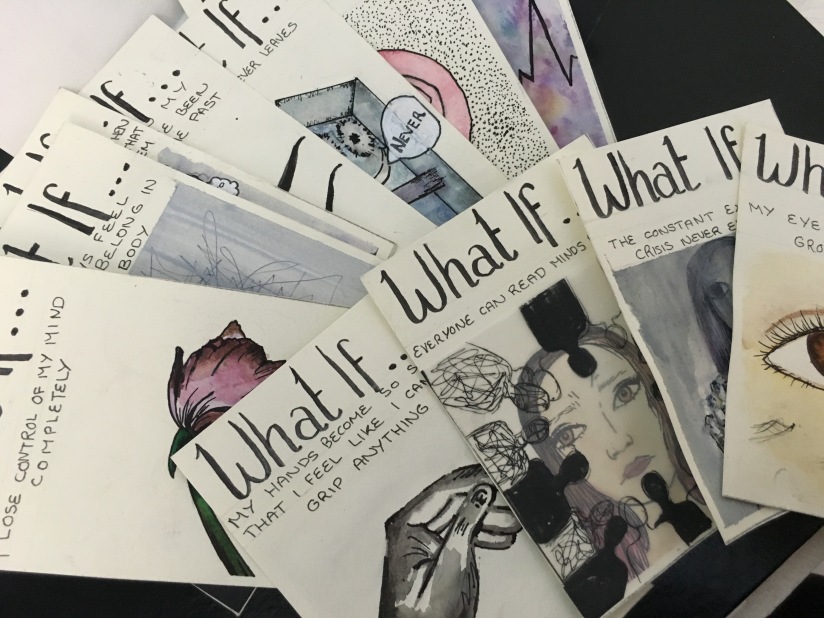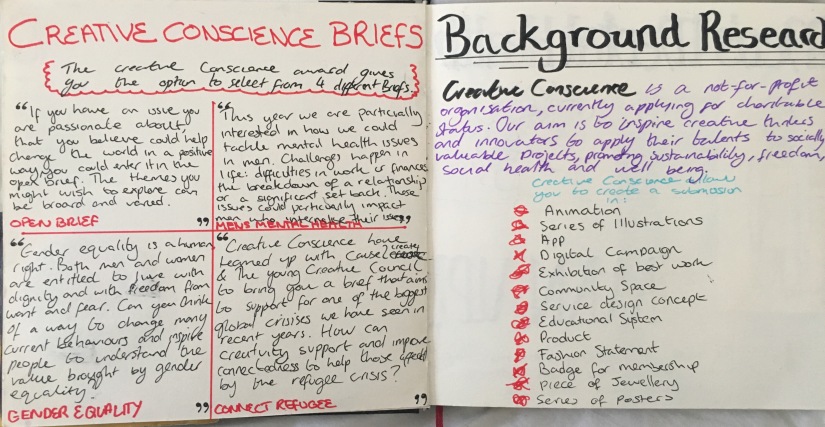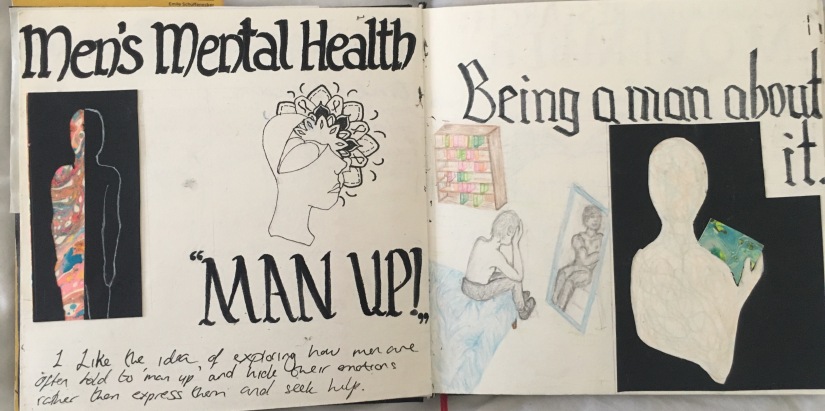Overall I’ve enjoyed creating my own brief and working through my structure and continued research into
Category: Uncategorized
Creative conscience Research
collections project test booklet


Here is my outcome for my test booklet, Now that i’ve completed these images to test out the imagery, technique, use of materials, text and layout i can reflect on this and choose what i want to change for my final collections project book. For example, I think the text would work better not on the images themselves. But If i had the text in another place in the book or if i made the images to be inside a pocket I’d be able to create a more interesting layout and make the images themselves stronger by having them stand alone.
collections project development


From the start of this project I was very excited. I was inspired by the initial briefing as this is the sort of project I’ve always wanted to do.
While playing around with ideas I was thinking of what happens to me personally on a monthly basis as I thought I could really make this project personal as it’s something I haven’t explored as much. An idea that I thought of using was as I dye my hair colourful colours every month and it gradually faded out I could have used that as my colour scheme. But after evaluating it I thought it could limit my artistic outcome with the images.
It then occurred to me to use my personal issues and struggles to express myself creatively. I came up with a project that turned into “what if… A collection of irrational fears”.
 After establishing my idea I started to brainstorm what content or ‘fears’ I was going to illustrate. As seen in the above image you can see I wrote down a list throughout the month of my irrational fears/thoughts. I also wanted to include other people’s fears to make my project more relatable to my audience, I set up a anonymous page for people to submit their irrational fears as this could be something very personal which they may not be comfortable publicly sharing.
After establishing my idea I started to brainstorm what content or ‘fears’ I was going to illustrate. As seen in the above image you can see I wrote down a list throughout the month of my irrational fears/thoughts. I also wanted to include other people’s fears to make my project more relatable to my audience, I set up a anonymous page for people to submit their irrational fears as this could be something very personal which they may not be comfortable publicly sharing.
After I sorted my content out I did some rough sketches in my research book. I wanted to come up with multiple sketches of possible imagery for each fear.
Layout is important; I wanted to make sure that the series tied together and were presented well. I created a portfolio type fold out test booklet and included my individual illustrations of my fears inside which all had the same format: title at top, the fear, the image. I used this as a test run for my images and to experiment with having images on a piece of card rather than a page in a book, as eventually I’d like my book to have images on something that can pop out rather than just flick through.
Dissertation Preparation Conclusion:
While researching for my dissertation proposal I found various articles, books, and artists who have furthered my interest and understanding in skin phobias, the abject body and art focusing on these subjects. The work I have documented has inspired me to look further into case studies looking at skin phobias, and to start making links and comparisons between art work representing the issues I’m researching.
Abjection research: Abject Art – The Tate



“Abject art is used to describe artworks which explore themes that transgress and threaten our sense of cleanliness and propriety particularly referencing the body and bodily functions”
content found on: http://www.tate.org.uk/learn/online-resources/glossary/a/abject-art
The term abjection refers to ‘the state of being cast off’. The abject has been researched and documented by various writers and is described as an:
“complex psychological, philosophical and linguistic concept developed by Julia Kristeva in her 1980 book Powers of Horror. She was partly influenced by the earlier ideas of the French writer, thinker and dissident surrealist, Georges Bataille. Kristeva herself commented: ‘refuse and corpses show me what I permanently thrust aside in order to live’. In practice the abject covers all the bodily functions, or aspects of the body, that are deemed impure or inappropriate for public display or discussion.”
The abject has a strong feminist context, in that female bodily functions in particular are ‘abjected’ by a patriarchal social order. In the 1980s and 1990s many artists became aware of this theory and reflected it in their work. In 1993 the Whitney Museum, New York, staged an exhibition titled Abject Art: Repulsion and Desire in American Art, which gave the term a wider currency in art.
Cindy Sherman is seen as a key contributor to the abject in art, as well as many others including Louise Bourgeois, Helen Chadwick, Paul McCarthy, Gilbert & George, Robert Gober, Carolee Schneemann, Kiki Smith, Sarah Lucas and Jake and Dinos Chapman.
Image content:
Piero Manzoni
Artist’s Shit 1961
Tin can with paper wrapping with unidentified contents
object: 48 x 65 x 65 mm, 0.1 kg
Purchased 2000© DACS, 2002
Jake Chapman, Dinos Chapman
Exquisite Corpse 2000
Etching on paper
image: 228 x 78 mm
Purchased 2000
© Jake and Dinos Chapman
Sarah Lucas
Chicken Knickers 1997
Photograph on paper
image: 426 x 426 mm
Purchased 1998© Sarah Lucas
Abjection Research: Scholarly Articles
content found on : https://www.sunypress.edu/pdf/61009.pdf
Skin representation in Art

Although not traditionally used as an item of artwork, Necropants are a type of trouser. They were made natively by Icelandic people in the 17th century. To make them, a person firstly needs to get permission to use another mans skin once he has deceased, he then had to dig up the body and peel of the skin from the waist downwards without making any holes or tears. The tradition then was that the wearer had to steal a coin from a widow at Christmas, Easter or Whitsun (a Christian festival of Pentecost, the seventh Sunday after Easter). Which He’d then place it in the scrotum of the trousers along with a sign which was seen to be magical called nábrókarstafur which is drawn on a piece of paper. The meaning behind the tradition was that they believed that it would gather wealth by superficial means, it drew money into the scrotum from living people so it will never be empty as long as the original coin is not removed.
Necropants could be considered to be grotesque as they show the naked body of another to the public which makes other people feel uncomfortable. The average person in todays society is used to their ‘norms’ for clothing in their culture so seeing something like this will make them feel uncomfortable as they would consider it grotesque as it is not socially acceptable to display one’s bare body. This is discussed in Margrit Shildrick’s The embodying the monster encounters with the vulnerable self, that
“The disruption of corporeal integrity and the open display of body vulnerability is always a moment for anxiety and very often for hostility”
Furthermore, Necropants could be considered to be grotesque by the material used to make it, many different materials are used to create clothing in fashion however using skin could be considered to be particularly grotesque as it uses something which is unsanitary and not conventionally used. Warwick and Cavallero spoke about this in ‘fashioning the frame’ “the skin is a broken surface…
a site of abjection because of its existence of these millions of ultimately unpoliceable holes…produces a desire to fill the space, to plaster over the frissure that betrays the self as fragmented”
This elaborates on how skin itself is a strange surface and how it could be considered grotesque by the fact it has holes in it.
Moreover Necropants also links in with my research on the abject body as Necropants are considered grotesque to people outside this culture where it is a norm, so much so that people separate themselves from it or are in ” the state of being cast off”. Necropants are a good example of how something which could be considered to be art or fashion can create a state of abjection on people when created using ‘grotesque’ materials such as skin.

Marc Quinn is an British Visual Artist and Sculptor. Quinn is a member of the ‘Young British Artists’ group and is better known for a Sculpture he did of Alison Lapper which has been installed on the fourth plinth in trafalgar square, London. However the work Im interested in researching is his project called ‘Self’ Which is an ongoing project of self portraits made using blood and silicone moulds.
Quinn’s work could be considered to be abject art as he doesn’t typically use conventional materials, He has used his own frozen blood, ice and faeces. These materials are considered to be grotesque to many viewers specially so because it is something we all have/ produce so it makes the work more personal to the viewer in making them feel abject as they try to separate themselves from the idea.
Quinn’s oeuvre displays a preoccupation with the mutability of the body and the dualisms that define human life—spiritual and physical, surface and depth, cerebral and sexual.
content found on: http://marcquinn.com/read/biography
Article on Colin Christians exhibition
Preview: Colin Christian’s “Trypophobia” at Stephen Romano Gallery

Trypophobia is the pathological fear of irregularly shaped holes. If looking at sponges, beehives, and raw meat makes you squirm, please look away. Colin Christian exploits people’s innate discomfort with porous organic matter in his new work for his January 3 solo show, “Trypophobia” at Stephen Romano Gallery in Brooklyn. While Christian’s doll-like sculptures have been featured on our blog many times, this is his most grotesque body of work yet. Toothy holes gnaw at the silicone flesh of his large-scale characters as if an alien parasite has invaded their bodies. Some of the sculptures feature close-ups of festering skin, which Christian displays in a medical fashion. He is clearly unafraid to repulse viewers with this exhibit.






Content from http://hifructose.com/2014/12/23/preview-colin-christians-trypophobia-at-stephen-romano-gallery/
Article on Art made of Flesh, bones and Blood.
Body Art: Creations Made of Human Flesh, Blood & Bones

What could be more personal and human than a cast of your head – made from your own frozen blood? The human body has been used as a canvas for all sorts of art, but perhaps more interesting and rare is the use of human body parts as artistic media, from sculptures made of hair, bones and fingernail parings to plasticized corpses in dynamic poses. These 12 artists have made human body art that is often controversial and sometimes surprisingly poignant.
Marc Quinn

(images via: art news blog)
If you’re going to do a self-portrait, why not go all out and make a sculpture out of your own frozen blood? That’s what sculptor Marc Quinn has done – every five years since 1991 – using a mold of his head and a whopping 9.5 pints of blood drawn over a period of five months. Quinn’s 2006 version of ‘Self’ was purchased by the UK’s National Portrait Gallery for over $465,000.
Andrew Krasnow

(images via: the independent)
It’s been called horrific and gruesome, but is Andrew Krasnow’s controversial skin art really a sensitive reflection on human cruelty? The artist creates flags, lampshades, boots and other everyday items from the skin of people who donated their bodies to medical science. Krasnow says that each piece is a statement on America’s ethics. “The objective was to express my concerns about the war and that it would not be conducted in a way that was moral and ethical,” he said. “Since that question wasn’t permitted in a museum, the work became more complex, with all the inherent contradictions of what it means to be an American or, for that matter, to be human.”
Gunther Von Hagens

(images via: body worlds)
Perhaps no artist using actual human flesh as his chosen medium has gained such renown as Gunther Von Hagens, the man behind the “Body Worlds” exhibition of plasticized human corpses. But for all the outcry regarding Von Hagens’ supposedly “disrespectful” usage of human bodies, there’s just as much fascination. Von Hagens invented plastination, the method of replacing water and fat in human tissue with certain plastics, preserving them for study.
Francois Robert

(images via: francois robert)
Francois Robert’s fascination with human bones started with an unusual discovery: an articulated human skeleton hidden inside a presumably empty locker that he purchased. Realizing the potential for artistic expression, Robert traded in the wired skeleton for a disarticulated one so that he could arrange the parts into shapes and designs. Since then, he has created a haunting photo series called ‘Stop the Violence’ that uses the stark-white bones on a black background to illuminate the inhumanity of war.
Anthony-Noel Kelly

(images via: anthony-noelkelly.com)
British artist Anthony-Noel Kelly followed in the footsteps of many artists before him, including Michelangelo, when he closely studied human body parts for his work. But unlike those artists, Kelly illegally smuggled human remains from the Royal College of Surgeons and used them to cast sculptures in plaster and silver paint. Kelly was found guilty of this unusual crime in 1998 and spend nine months in jail. The sculptures can still be seen on his website, anthony-noelkelly.com.
Kai-hung Fung

(images via: the daily mail)
CT scans are typically only interesting to health care practitioners and the patients whose bodies they portray on film, but artist Kai-hung Fung manipulates them into stunning artistic images. Lungs, arteries, vocal chords and ear canals are just a few of the body parts that Fung – a radiologist himself – has scanned into a computer, intensifying the color but otherwise not manipulating them in any way.
Linda Jones

(images via: wcax)
How would you feel if a relative of yours took bits of your hair, stitches from an injury, even catheters and other medical equipment and used it to build a creepy “family photo album?” Artist Linda Jones of Vermont turned such objects into an exhibition at Burlington’s Firehouse Gallery, shaping layers of wax, x-rays, teeth and even bits of flesh into abstract art. Of the show’s content and theme, gallery Curator Chris Thompson remarked, “Why do we simultaneously want to preserve life, modify our bodies, extend life, but at the same time, find the actual act of it very disturbing?”
Tim Hawkinson

(images via: flying out of this world)
Tiny and delicate, almost diaphanous, this little bird skeleton at first seems remarkable simply because it is so well preserved despite the fragility of bird bones. But those aren’t bones at all – they’re the fingernail clippings of the artist, Tim Hawkinson, carefully arranged into the 2-inch-tall sculpture.
Wieki Somers

(images via: herald sun)
Seemingly carved from concrete, the sculptures of Wieki Somers look weighty and hyper-realistic despite their lack of color. But these everyday objects, placed on beds of what looks like sand, are more organic than they appear – they’re made from human ashes. Somers uses donated remains and a 3D industrial printer to create art that questions our attachment to inanimate objects. “We may offer Grandpa a second life as a useful rocking chair or even as a vacuum cleaner or a toaster,” she told the Herald Sun. “Would we then become more attached to these products?”
Kim Do

(images via: oddity central)
You (probably) don’t mind wearing a sweater made from the wool of a sheep, so why not wear a dress made from human hair? Kim Do of Vietnam created this bizarre masterpiece from 1 million meters of human hair gathered from 54 different people, dyed and sewn together, with lighter brown hair creating the shape of a dragon on the front. It even comes with a matching hat, perched on the model’s head like a matted bouffant.
Huang Xin

(images via: the telegraph)
If a dress made from human hair wasn’t quite strange enough, another artist paid tribute to U.S. President Barack Obama with a sculpture made from – yes – hair. Hairdresser Huang Xin celebrated Obama’s visit to China by molding a mini hairy Obama sculpture using hot glue and tons of dyed hair.
Kittiwat Unarrom

(images via: inventorspot)
The lone mention on this list that isn’t made from actual human body parts gains a spot merely because the realism of this work is so shocking. Thai artist Kittiwat Unarrom has disgusted and intrigued many a passer-by with his “human body parts” on display, butcher-style, hanging from hooks and laid out like choice cuts of meat. The thing is, Unarrom’s works aren’t actually the spoils of a serial killer, or garnered from human donors. They’re actually made from bread, but you would never guess by looking at it – which is why they make such great gag gifts.
content found on: http://weburbanist.com/2010/08/23/body-art-creations-made-of-human-flesh-blood-bones/






